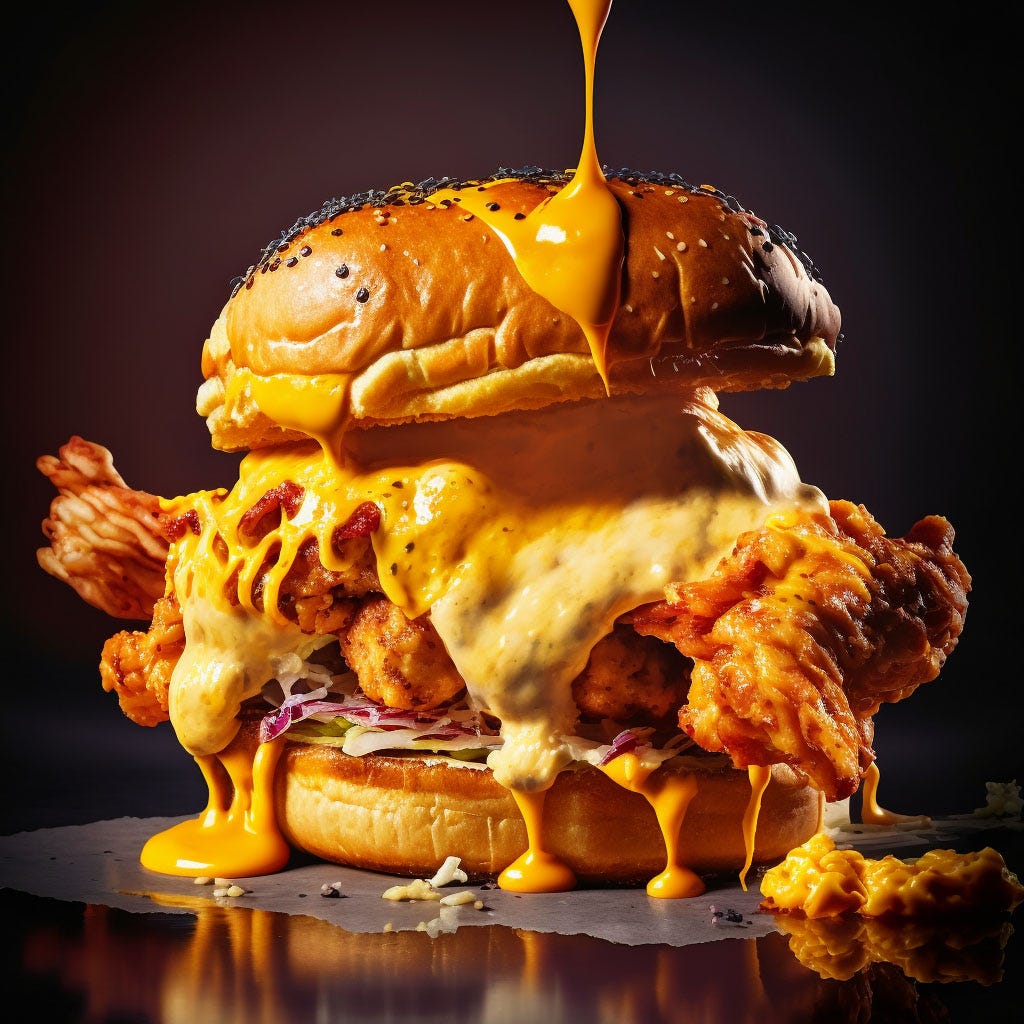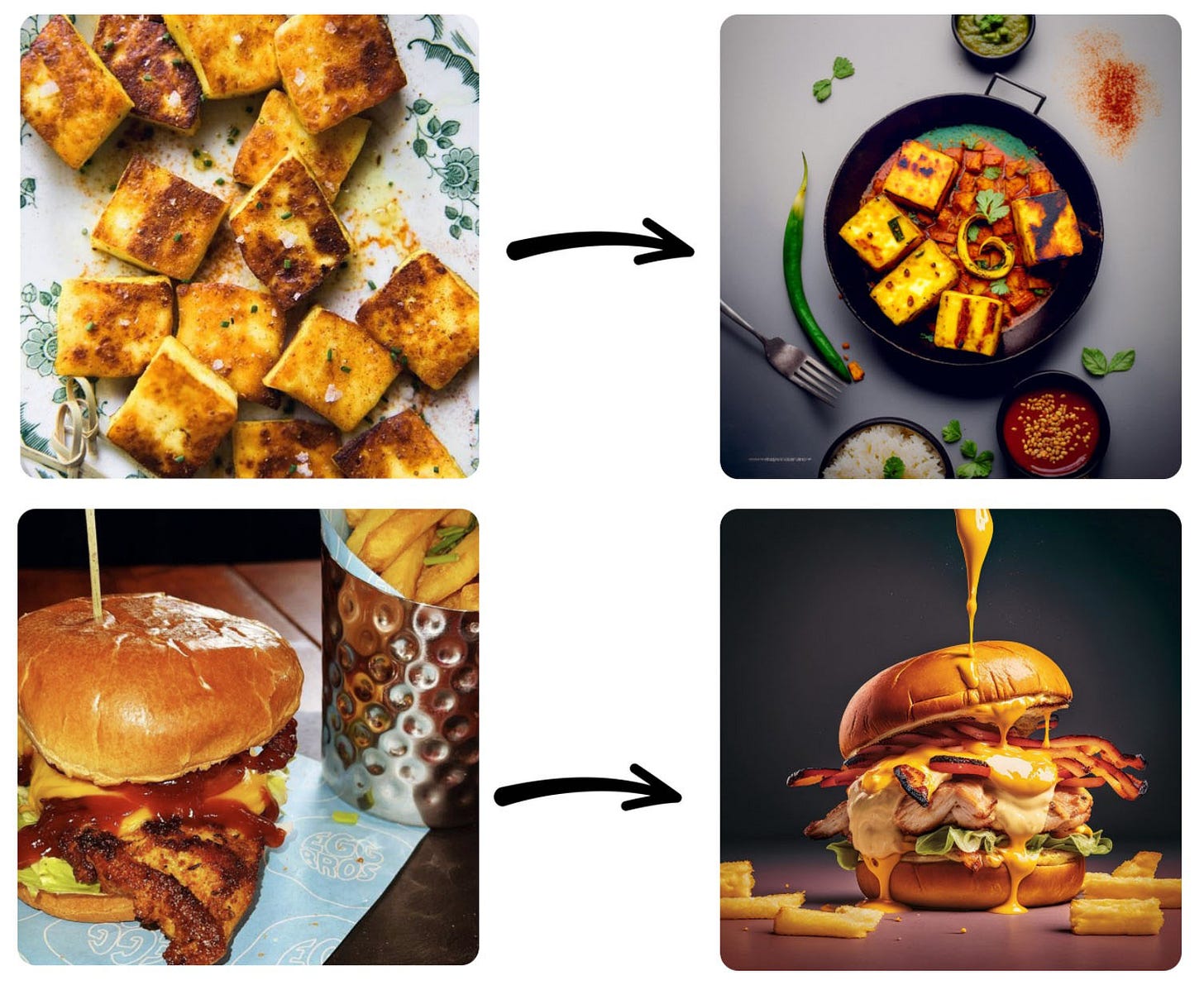AI Startup idea: Product Photography
I tried to make product photography 1000x cheaper using Generative AI
Are you more likely to order food if the menu has pictures? So why do so many restaurants use poor quality images for their food, and why are so many Uber and Deliveroo menus without photos?
When I was working on Buskana for festivals I saw first hand that menus with photos received 30% more order volume than menus without photos. I ran my own Twitter poll and results supported my observations.

Restaurants pay £300-£1,500 per month for food photography
In a past life when I was working more actively on Halal Joints, I experimented with running social media accounts for restaurants. I’d hire a photographer to take photos and a university student to select the best ones and post them to Instagram with creative captions. Restaurants would pay me anything between £300 and £1,500 every month for the service.
My biggest cost was the photographer. It cost me a few hundred pounds for a shoot with a photographer, and I’d need to get new content shot about once every 45 days. Sadly I could never find enough photographers at a good rate to scale this beyond just a handful of restaurants. Photographers are always busy, restaurant owners are disorganised and often I’d pay a premium for last-minute rescheduling for shoots.
And when the photographer turned up to the store, the restaurant wouldn’t be prepared for shooting. So I’d lose another two hours of my photographer’s paid time.
So when Midjourney v4 launched, I was excited by the productivity boost it could offer…
I was (and still am) a noob at prompting so I would type in a brain vomit of words including “professional photography”, “studio lighting”, “brioche bun” and BOOM! A delicious burger would appear on my screen:
I asked myself: if high-quality imagery of food is so easily accessible now, without the need of a professional photographer, can the massive restaurant industry see an almost immediate benefit of increased order volume and basket size just by updating their images to something more appetising?
Deliveroo is full of restaurants with bland menus
Open up the Deliveroo website, and once you scroll past the “featured” suggestions you’ll find most restaurants and delivery kitchens are selling food by titles and descriptions only. The placeholder for menu images was often blank.
Try Instagram next: smaller establishments post low-quality, blurry images of food which don’t stand a chance against larger chains that have in-house media and production teams.

But on the bright side, all of the businesses mentioned above have some kind of digital presence. I like that, because it makes them easier to find, scrape, cold-message and engage with.
Easier to engage with? Pfft! Wrong!
Restaurant owners spend most of their energy on staying afloat
Most entrepreneurs I speak to in food and hospitality speak of their love and passion for food (and offering a friendly service to guests). I’m not surprised, since they can hardly boast about margins. The restaurant industry is notorious for it’s low margins.
Despite most businesses aiming for a gross margin of 75% per item - once staff, utility bills, rent and taxes are account for, the owner barely takes home 7%. And that’s after the initial investment of setting up the business which can easily run in to tens of thousands even for a small fast-food takeaway.
As a result, these business owners can typically be found working a second job to keep their restaurant business alive. When they weren’t busy in the kitchen, or working their part-time job I would get pockets of time to speak with them about their business and marketing approaches…
I created an example to show restaurant owners
I needed to talk to customers and show them what was possible. And better yet, I needed them to pay me before I started building.
I am a strong believer that the best demo involves zero lines of code. I believe writing code to build a demo is the sheepish way of hiding behind the flaws of your idea. And in the early stages, allowing customers to point out the flaws is critical. Every point they make is a reason they won’t pay for your product. Address them, and you should soon have a product they will pay for without hesitation.
I decided the best demo would be something that explained the product by example. I took a bunch of medium-low quality images of food from Instagram and used Midjourney to generate some examples of the transformation that could be achieved. My co-founder came up with this brilliant graphic that powerfully showcases the potential:
It wasn’t difficult getting customers excited
Together, me and my co-founder used the graphic to seek out our first customer.
Without exception, everybody that saw the example was mind-blown at just how transformative this technology was. We could tell they still didn’t grasp how it worked, and still asked questions like “When did you take that picture?”.
It quickly became obvious that the majority of restaurant owners aren’t tech-savvy. They’re typically hands-on operators that roll up their sleeves and get stuck in with serving customers and cooking in the kitchen.
Since they were operating in the kitchen, I discovered that restaurant owners typically outsource their digital work, including photography. This was a reassuring discovery because it meant that I was moving in the right direction of selling a better service for something they were already paying for.
On the top end, restaurants were paying agencies up to £1,500 per month to run their social media accounts and handle all food and product photography. I was estimating my service could generate 1,000 images for less than £15.
I had both pieces of the puzzle in my hand. All I needed to do was orientate them to fit, or at least that’s what I thought…
Taming the beast whilst wrestling your customer is not the foundation of a compelling business case
Annoyingly, the AI didn’t always play ball. It would sometimes throw me a lemon when generating images of food resulting in inconsistent output. For example, generating a burger would sometimes create a seeded bun without a tomato and other times a seedless bun with a tomato but no pickle. FOR ABSOLUTELY NO REASON.
On top of this, restaurant owners seemed incredibly picky about images. They’d expect the burger sauce to be a very specific shade of yellow, and cucumbers to be cut in a very particular way. Unfortunately, there’s no real way to control these parameters in the current versions of Dall-E, Stable Diffusion and Midjourney.
I tried using hacky approaches including images as input prompts, chaining images to maintain consistency, negative prompts, de-noising and training Stable Diffusion models with Dreambooth. The technology just isn’t quite there for this use-case.
Custom-trained Stable Diffusion models was the pick of the bunch in terms of solving the problem. But, I gave up before making meaningful progress worth sharing because training each model costs around $2.50 and requires 20 input photos. That’s far too much effort for each and every menu item and pegs the idea down on being faster, easier and cheaper. Ideally, I wanted to supply one low-res image and get back thousands from which I could choose the best.
Note: Since I originally started writing this post, ControlNet has been released and offers way more control over output images. I haven’t had a chance to experiment yet.
Conclusion: Restaurants spend 90% of their efforts on staying afloat. If you’re not providing them with immediate utility, there isn’t a sale to be made
The sad truth of it is that a restaurant’s lifespan is somewhere between 2-5 years. They go bust pretty quick. It’s an industry with very tight margins and operators that don’t have a uniform profile when it comes to categorising them for outreach.
Some of the restaurants I spoke to whilst exploring this idea were more excited by the discount they got on their fryer than whether they were actually offering any fried food on their menu!
Thousands of business have sold, and are currently selling, to restaurant owners and making lots of money. However, I don’t feel this is a customer profile I enjoy working with, despite their day-to-day problems being relatable, interesting and easily sold with technology.
The market size for restaurants (and the hospitality industry in general) is huge. From the majority of independently-run restaurants I have spoken to it seems their business decisions are largely emotionally driven which makes it frustrating to sell based on value-add and logic. Maybe I’m doing it wrong - but for now at least I think my time is better used looking elsewhere to explore different ideas.





